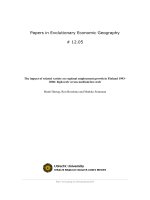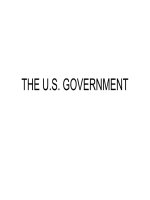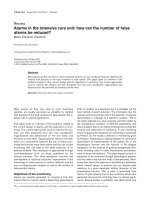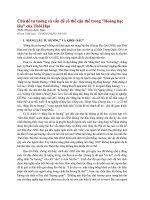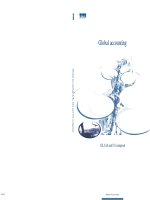Can the growth in the US current account deficit be sustained
Bạn đang xem bản rút gọn của tài liệu. Xem và tải ngay bản đầy đủ của tài liệu tại đây (300.4 KB, 12 trang )
The Levy Economics Institute of Bard College
Strategic Analysis
May 2006
CAN THE GROWTH IN THE U.S.
CURRENT ACCOUNT DEFICIT BE
SUSTAINED? THE GROWING BURDEN
OF SERVICING FOREIGN-OWNED
U.S. DEBT
. , ,
Introduction
Can the growth in the U.S. current account deficit be sustained? How does the flow of deficits feed
the stock of debt? And how will the burden of servicing this debt affect future deficits and eco-
nomic growth? These are some of the questions we address in this Strategic Analysis.
The U.S. current account deficit has been steadily growing since the early 1990s. By the end of
2005,
it st
o
o
d at almost 7 p
ercent of GDP. The deficit increased from $185.4 billion in the third
q
uarter of 2005 to $224.9 billion in the fourth quarter (BEA 2006b). For the year, the U.S. current
a
c
c
ount d
e
ficit incr
ease
d o
v
er 20 percent, from $668.1 billion in 2004 to $804.9 billion in 2005.
A
ft
e
r y
ear
s of current account deficits, U.S. foreign liabilities now exceed U.S. foreign assets by nearly
$2.5 t
rillion. Yet, despite the deterioration in the U.S. position, income on foreign assets almost
mat
c
hes the inc
o
me o
n f
o
r
eign liabilities. Because net income flows to the United States remain
ne
u
t
r
al, the burden of servicing the external debt appears inconsequential to some. But appear-
ances can be misleading. We take issue with the view that just because income flows are currently
ne
u
t
r
al,
the
r
e is little r
eason for concern. If interest rates continue to rise, the current account
d
e
ficit w
il
l continue to worsen. In this Strategic Analysis, we examine views on the effect the cur-
rent account deficit and the net international investment position of the United States will have on
fu
t
ur
e g
r
o
w
th. We focus on the cost of funding debt and the structure of U.S. assets relative to U.S.
T
he L
e
vy Institute’s Macro-Modeling Team consists of
.
,
.
,
,
. , and . All questions and correspondence should be directed to Professor Papadimitriou at
845-758-7700 o
r
The authors wish to acknowledge comments from Anwar M. Shaikh and Wynne Godley. All errors remain with the authors.
g
lut. While they concede that the glut has less to do with mar-
k
et mechanisms and more to do with policy initiatives of for-
e
ign governments, they do not believe that the trade deficit
r
eflects inadequate economic policies within the United States.
B
en S. Bernanke (2005) is one of those who locate the
p
rincipal cause of the U.S. current account deficit abroad.
Recently, as chairman of the Federal Reserve, Bernanke has
offered a number of compelling reasons for the downward
pressure on long-term yields (2006, pp. 3–5). Among them, he
cites a stable inflation outlook, increased currency market
intervention by foreign governments, and a decrease in the
supply of long-duration securities.
While accepting that foreign government policies are
largely responsible for the current global imbalances, Federal
Reserve officials also believe that it will be markets rather than
government policy that will benignly unwind these imbal-
ances, with little effect on the U.S. economy. Federal Reserve
Governor Donald L. Kohn (2005), speaking at The Levy
Economics Institute last year, remarked: “In all likelihood,
adjustments toward reduced imbalances in the United States
and globally will be handled well by markets without, by them-
selves, disrupting the good, overall performance of the U.S.
economy—provided, of course, that the Federal Reserve reacts
appropriately to foster price and economic stability.” Bernanke
also envisions a smooth adjustment (2005, p. 9).
While U.S. policymakers choose not to take action, foreign
central bankers openly express their concern. In particular, Asian
central bankers express doubt about the sustainability of grow-
ing imbalances. Toshihiko Fukui, governor of the Bank of Japan,
suggested in October 2004 that global imbalances risk the stabil-
it
y of the international financial system. The willingness of Asian
monetary authorities to intervene in currency markets to prop
up the dollar may be limited. Fukui notes that in accumulating
so man
y dollars, Asian central banks are running the risk of put-
ting all their “eggs in one basket” (2004, p. 2). This, coupled with
a “sudden shift in sentiment over the dollar,” could lead to prob-
le
ms. Joseph Yam (2004), chief executive of the Hong Kong
Monetary Authority, notes that Asian central banks have accu-
mulated huge reserve positions, primarily in U.S. dollars.
Some European bankers share the concern among Asian
central bankers. Jürgen Stark, vice president of the Deutsche
Bundesbank, suggests that the magnitude of the coming adjust-
ment is “significantly larger” than those of the past (2005, p. 2).
While foreign bankers are calling for changes in U.S. economic
2 Strategic Analysis, May 2006
liab
ilities. We find that temporary policy measures have masked
the fu
ture costs of servicing foreign-owned U.S. debt.
V
iews vary as to whether the growth in the current account
d
eficit presages trouble for the U.S. economy. Our colleague
W
ynne Godley has been warning of the dangers inherent in run-
ning t
rade deficits for some time. Godley points out that the
growing external debt of the United States matters for the same
reason a growing debt matters to any entity: a growing debt gen-
erates a growing debt service burden (1995, p. 11). He warns that
the outflow from servicing the foreign debt acts as a “kind of
hemorrhage from the circular flow of national income” (p. 13).
In Levy Institute Policy Notes and Strategic Analyses that date
back many years, Godley has stressed that the longer these
deficits persist, the more difficult the eventual correction will be.
Nouriel Roubini and Brad Setser point out that interest
payments on existing external debt have not been much of a
burden on the U.S. economy, because of low interest rates and
the willingness of external investors to finance the large U.S.
current account deficit (2004, p. 3). They suggest that the accu-
mulation of reserves by Asian central bankers is financing a
growing share of the U.S. current account deficit. They note
that private investors will be less willing to finance the ongoing
current account deficits at low interest rates, and contend that
stability hinges on the willingness of Asian central bankers to
step in during a crisis (pp. 6–9).
Terry McKinley (2006) emphasizes the interdependence of
the world economy and the implications of structural adjust-
ment. He argues that the rise in U.S. expenditures has been
made possible by the saving of developing countries. Others,
including William R. Cline (2005), emphasize structural fac-
t
ors, such as the earnings on U.S. foreign assets exceeding earn-
ings on U.S. foreign liabilities, to explain the imbalance. Cline
acknowledges that if foreign investors and central banks were
t
o curb their financing, it could lead to a “wrenching” impact
on the U.S. economy. But he argues that the stability of U.S.
financial markets, with their associated legal guarantees and
t
ransparency, make the United States an attractive place for for-
eign investors (p. 49). He contends that the lower risk of U.S.
assets helps explain the lower rates of return.
Among U.S. policymakers, the prevailing view is that the
source of the current account deficit stems from abroad, that lit-
tle can or should be done in the United States, and that markets
will benignly resolve imbalances. A few Federal Reserve officials
argue that the trade deficit exists because of a global savings
to imported goods and services in historical dollars for every
quarter since 1960. Since the late 1990s, this ratio has fallen
from .80 to .66. This dramatic falloff suggests that current
trends are unsustainable.
Imports as a percent of GDP have grown rapidly, repre-
senting about 16 percent of GDP at the end of 2005. Exports
have been flat since 2000, and represented just over 10 percent
of GDP at the close of 2005. Yet, as Figure 2 shows, the balance
on income has not followed the downward trend in the balance
on goods and services. Why hasn’t the accumulated debt stem-
ming from past trade deficits dramatically changed income
flows? As we will show later, several reasons help explain why the
balance on income flows remains near zero—including low
interest rates and the shorter maturities of debt instruments.
0.7
0.9
1.1
1.3
1960 196619721978 1984 1990 1996 2002
Figure 1 Export-Import Ratio of Goods and Services
Source: Bureau of Economic Analysis
Figure 2 Balance on Income and Balance on Goods and
Services as Percent of GDP
Source: Bureau of Economic Analysis
Percent of GDP
-6
-4
-2
0
2
1960 1965 1970 1975 1980 1985 1990 1995 2000
2005
Balance on Income
Balance on Goods and Services
p
olicy, U.S. monetary authorities downplay the significance of
an
y impending adjustment. Fukui says, “Policymakers must
r
eassure the market that they are not letting imbalances get out
o
f hand” (2004, p. 2). He says:“Without changes in the conduct
o
f economic policy this would also mean that the existing
g
lobal current account imbalances would become even more
pronounced.” Others, such as Dr. Y. V. Reddy, governor of the
Reserve Bank of India, say the possibilities of disruptive global
currency adjustments are high, and that there is a need for
“bold leadership” to correct global imbalances in an orderly
manner (2004, p. 1).
Federal Reserve economists Matthew Higgins, Thomas
Klitgaard, and Cedric Tille (2005) break out the assets and lia-
bilities of the U.S. international investment position and their
corresponding flows, and conclude that a series of fortunate,
and possibly temporary, events have prevented a deterioration
in U.S. net income receipts. They note that much of the buildup
in U.S. liabilities has taken the form of interest-bearing assets
(p. 12). They contend that the superior return the United States
earns on foreign direct investment and the drop in global inter-
est rates have masked potential changes in payment flows (p. 17).
Until recently, the debate over the current account balance
focused primarily on whether the impending adjustment
would be benign or potentially damaging to the U.S. and world
economies. Nobody was questioning whether or not an adjust-
ment to the U.S current account balance was forthcoming
(Altig 2005). Richard Hausmann and Frederico Sturzenegger
(2005), at the Kennedy School of Government at Harvard
University, have taken a far-out position and suggested that no
such adjustment is imminent. They argue that all accounting
sy
stems are arbitrary, and contend that assets and liabilities
have been systematically mismeasured: measurement error has
created “dark matter” that will keep global financial markets
fr
om running into a crisis. They suggest that accounting con-
ventions are inadequate and propose to measure assets by the
income they generate (p. 9). Because the United States received
a ne
t income of $30 billion on its financial portfolio, they con-
tend that it is a net creditor.
In this Strategic Analysis, we show that net income out-
flows are artificially low, largely because of temporary events
and policies that may be in the process of reversing. The
potential problems in income outflows stem from past trade
deficits. Since the mid 1970s, the United States has imported
more than it has exported. Figure 1 shows the ratio of exported
The Levy Economics Institute of Bard College 3
4 Strategic Analysis, May 2006
Despite the growth in foreign-owned interest-bearing
assets, interest income payments and receipts have fallen in
relation to GDP. Figure 4 shows both U.S. interest payments to
foreigners and U.S. interest receipts from foreigners as a per-
cent of GDP. This figure shows the falloff after 2000—a falloff
that occurred despite rapid growth in the stock of interest-
bearing assets shown in Figure 3. The apparent incongruence
between the recent growth in foreign ownership of interest-
bearing assets and the recent decline in U.S interest payments
to foreigners is explained by the dramatic decline in interest
rates since 2000.
The cost of funding U.S. credit market debt has also
declined considerably in the last five years. To estimate the cost
o
f
funding d
e
bt, we use U.S. Bureau of Economic Analysis
(BEA) data and tak
e the ann
ual flo
w o
f interest divided by the
average stock of debt (over a two-year period) measured at
cur
r
e
nt c
osts.
I
n the mid 1980s,
the funding costs of debt were
ar
ound 8 p
e
rcent. These costs hovered near 6 percent from
the mid 1990s to 2000, but from 2000 to 2004, they dropped
c
o
nsid
e
r
ab
l
y. This is shown in Figure 5. The separation of the
tw
o lines sho
w
s that the funding cost for the United States
relative to that of foreigners rose modestly. In 2004, the fund-
ing c
ost was ar
ound 3.02 p
e
r
c
ent for the United States, and a
little o
v
er 2.59 percent for foreign credit market assets in the
United States.
As a result of the growing U.S. current account deficit,
credit market instruments and equity held by foreigners as a
share of U.S. financial assets have grown rapidly in recent
years. There has been a steady increase in U.S. assets held by
foreigners since the early 1970s, when foreigners held less than
2 percent of the total dollar value of the U.S. credit market.
Today, they hold almost 14 percent (Federal Reserve Board of
Governors 2006). A similar pattern exists for the U.S. equity
market. In the early 1990s, the share of the total dollar value of
the U.S. equity market held by foreigners was less than 4 per-
cent. Today, foreigners hold over 12 percent.
U.S. assets exceeded U.S. liabilities until the late 1980s.
Since that time, liabilities have exceeded assets. The acquisition
of domestic assets by the rest of the world provides funding
in U.S. capital markets. Figure 3 shows that U.S. ownership of
foreign interest-bearing assets as a percent of GDP has grown
modestly. In contrast, foreign ownership of U.S. interest-
bearing assets has grown rapidly, particularly since 1999. At
the end of 2004, foreign ownership of U.S. interest-bearing
assets stood at over 60 percent of GDP, while U.S. ownership
of foreign interest-bearing assets was just over 30 percent.
Because the bulk of foreign-owned securities are credit market
assets, the current account deficit is becoming more sensitive
to changes in interest rates.
Figure 3 U.S. and Foreign Interest-Bearing Assets
as Percent of GDP
0
20
40
60
1982 198619901994 1998 2002
Foreign Ownership of U.S. Interest-Bearing Assets
U.S. Ownership of Foreign Interest-Bearing Assets
Source: Bureau of Economic Analysis
Percent of GDP
Figure 4
Interest Income Flows as Percent of GDP
0
0.5
1.0
1.5
2.0
2.5
3.0
1976 1980 1984 1988 1992199620002004
Source: Bureau of Economic Analysis
Percent of GDP
U .S. Interest Payments to Foreigners
U.S. Interest Receipts from Foreigners
The movement in market interest rates explains much of
the falloff in funding costs since 2000. The Federal Reserve
aggressively targeted the federal funds rate beginning in early
2001. The movement in this rate is shown in Figure 6. The drop
in the federal funds rate affected the yields on short-term debt,
as reflected in the U.S. Department of the Treasury’s published
data on yields. Beginning in 2001, short-term interest rates fell
dramatically. As shown in Figure 6, six-month Treasury yields
fell from over 6 percent in 2000 to 1 percent in 2003, with the
Treasury yields closely following the movement in the federal
funds rate.
The Levy Economics Institute of Bard College 5
Another reason for the falloff in U.S. funding costs has
been the shift in the instruments used to fund the U.S. national
debt. In recent years, the funding policy of the Treasury has
changed. Figure 7 shows the average maturity of total out-
standing and newly issued U.S. government debt. Prior to 2000,
the average maturity of newly issued debt never fell below 50
months. After 2000, it fell to well below 30 months. The aver-
age maturity of newly issued debt dropped considerably in the
first quarter of 2002. At that time, newly issued debt had an
average maturity of 25.48 months. This, along with debt that is
rolling over, has had the effect of lowering the overall maturity
of debt. In the fourth quarter of 2005, the average maturity for
all U.S. government debt dropped to 53.36 months—the lowest
level since the second quarter of 1984. Although the Treasury
has r
e
int
r
o
duced the 30-year bond and has begun funding more
w
ith long-term debt, the average maturity of newly issued debt
remained well below 40 months in the most recent quarter.
M
at
ur
it
y le
ngths should stabilize as the benefit offered by fund-
ing w
ith low short-term interest rates disappears.
Other financial entities, such as banks and hedge funds,
also o
ft
e
n lo
ok t
o fund a good deal of their long-term assets
w
ith short-term liabilities. Although prudent banking requires
that long-term assets be funded with long-term liabilities, the
financial inc
e
nt
i
ves of expanding the net interest margin by
funding long-term debt with commercial paper are enticing.
Table 1 shows the projected income effect from a change in
the c
ost o
f
funding
. We use 2004 estimates for credit market
assets and liabilities. At the end of 2004, U.S owned credit
Percent
Figure 5
Estimated Cost of Funds
4
0
8
12
1983
1987 1991 199519992003
Interest Payments / Foreign-Owned Credit Market Assets in United States
Interest Receipts / U.S Owned Credit Market Assets Abroad
Source: Bureau of Economic Analysis
Percent
Sources: Federal Reserve Board of Governors and Department of the Treasury
Figure 6 Federal Funds Rate and U.S. Treasury Yields
0
2
4
6
8
19911993199519971999200120032005
20-Year Treasury Yield
10-Year Treasury Yield
6-Month Treasury Yield
Federal Funds Rate
Figure 7 Average Maturity of Outstanding and
Newly Issued U.S. Government Debt
20
40
60
80
100
1980 1984 1988 1992 19962000 2004
Months
Average Maturity of Newly Issued Debt
Average Maturity of Total Outstanding Debt
Source: Department of the Treasury
T
able 1
A
ctual and P
r
ojected Interest Income Flows Based on 2004 Assets
*
Income Flows
2004
P
rojected
U.S. Cost of Funding (Percent) 2.59 4.00 5.00 6.00 7.00 8.00
F
oreign Cost of Funding (Percent) 3.02 4.00 5.00 6.00 7.00 8.00
U.S. Interest Receipts (Billions) $103 $159 $199 $238 $278 $318
U
.S.
I
nt
e
rest Payments (Billions) $228 $303 $378 $454 $530 $605
N
et Interest Income Flows (Billions) -$125 -$144 -$180 -$216 -$252 -$288
Relative to 2004 (Billions) -$18 -$54 -$90 -$126 -$162
*Based on foreign credit market assets held by United States of $3.97 trillion and $7.56 trillion in U.S. credit
market assets held abroad
Sources: Bureau of Economic Analysis and authors' calculations
period. In other words, the effects of recent increases in interest
rates still have not markedly affected the income-flow statistics.
Another reason the balance on income has remained near
zero in the last few years is that foreign central banks have accu-
mulated large U.S. dollar–denominated reserves earning low
returns. Figure 8 shows Treasury and agency securities held by
foreign central banks as a percent of U.S. GDP. The willing-
ness of foreign central banks to continue this policy may soon
end. Government officials in China have been suggesting that
China may soon stop accumulating U.S. dollars in their foreign
exchange reserves.
6 Strategic Analysis, May 2006
market assets were worth approximately $3.97 trillion.
Foreign-owned credit market assets in the United States
amounted to $7.56 trillion. If the cost of debt were to rise to
5 percent from 2004 levels of around 3 percent, we would
expect interest receipts to rise from $103 billion to near $199
b
illion. Income payments would rise from $228 billion to $378
billion. The net income flow would deteriorate by an additional
$54.39 billion. If the cost of debt were to rise from 2004 levels
to 6, 7, or 8 percent, the net income flow would deteriorate by
$90.33, $126.27, or $162.21 billion, respectively.
Based on 2004 data, we estimate that for each percentage-
point rise in funding costs, an additional $36 billion will be
added to the current account deficit. If U.S. debt were to be
viewed as riskier than foreign debt, and the cost of funding
were to rise relative to foreign debt, the effect would be even
more pronounced. Moreover, foreign ownership of U.S. credit
market assets has grown considerably since the end of 2004,
and much of the new U.S. debt has been funded with short-
term maturities, which means that funding costs for the United
States should rise more rapidly than in the past.
Our econometrics shows that an increase in the federal
funds rate will affect the ex-post return on U.S. assets held abroad
slowly. We found that an increase of 100 basis points implies an
increase in the ex-post return of about 75 basis points, with a
mean lag of about two years. Accordingly, while the federal funds
rate increased from 2.9 percent in the second quarter of 2005 to
4.4 percent in the first quarter of 2006, the ex-post return on U.S.
assets held abroad increased by only 0.4 percent over the same
Figure 8 Rest of the World Official Treasury and
Agency Security Assets as Percent of GDP
0
4
8
12
19751980 19851990 1995 2000 2005
Sources: Federal Reserve Flow of Funds and Bureau of Economic Analysis
Percent of GDP
U.S. Government funding of debt with short-term securi-
ties, low interest rates, and the buildup of foreign central bank
reserves have so far prevented income flows from contributing
to the current account deficit.
Scenarios
Our scenario analysis is based on the same premises we used to
make the projections in our September 2005 Strategic Analysis.
At that time, we used information from the first half of 2005,
and noted that if output in the United States grew sufficiently
to keep unemployment constant, the deficit in the current
account would likely worsen. We projected that the current
account deficit would reach 7.5 percent of GDP by the end of
the decade. Our projection was conditional on the assumption
that the private sector’s net financial balance, which was nega-
tive 2.6 percent of GDP in the second quarter of 2005, would
slowly move back to zero over the next five years through a
deceleration in the growth rate of household borrowing. We
projected that this would eventually flatten household debt
relative to income, which was at the time at historic highs.
Since the external sector’s contribution to aggregate demand
was negative, a slowdown in private sector borrowing and
expenditure implied that government spending would be
required to fuel growth. We estimated that the general govern-
ment deficit would also reach 8.5 percent of GDP by the end of
the decade.
None of the unsustainable trends we highlighted changed
in the last part of 2005. On the contrary, the private sector bal-
anc
e,
aft
er a small reduction in the third quarter, set a new
record: negative 3.2 percent of GDP at year-end. Household
debt rose to 90 percent of GDP, or 107 percent of private sec-
tor income. Oil prices, which rose through the third quarter of
2005, leveled off at the end of the year, leading to an increase in
oil imports of about 0.5 percent of GDP in the last part of 2005.
This increase contributed to the deterioration of the current
account balance, which fell to negative 6.9 percent of GDP by
year-end. If we look at the current account balance compo-
nents in Figure 9, we see that, excluding oil imports, the deficit
has leveled off with respect to GDP.
In the past, net income flows have provided a positive contri-
bution to the current account balance, since the net return on
foreign investment has exceeded net interest outflows on interest-
bearing assets. However, interest rates have risen. Foreign debt
has increased. And, the benefits of positive income flows for the
United States have now come to an end. The latest figures on
income flows show that inflows and outflows are roughly
equal. We expect net interest payments to foreigners to grow,
and net payments on direct investment to remain stable.
At the end of 2005, the U.S. economy continued to grow
on an unbalanced path. It follows that new projections using
the same assumptions as in our previous analysis will show
worse outcomes, since the starting points—for both the exter-
nal deficit and private sector debt—are higher than six months
ago. We have repeated our exercise, again assuming that private
sector borrowing—and household borrowing in particular—
slo
wly declines and brings the private sector back to balance by
the end of the decade. This implies that household debt will
le
v
el off at about 102 percent of GDP. We expect nonfinancial
business debt to stabilize at 68 percent of GDP. We also assume
no devaluation of the dollar and no further increase in the
r
elative price of oil. We assume a moderate increase in the fed-
eral funds rate of about 130 basis points in the next year. Our
estimates show that this will lead to a moderate increase in
int
erest rates paid on U.S. assets held abroad, which will con-
tribute to the worsening of the current account balance.
Aligning our model to obtain the same growth path projected
by the Congressional Budget Office (CBO) in its January 2006
report—a path that implies stable unemployment—we find
that if net exports and private sector expenditure do not pro-
vide the fuel for growth, such an expansionary path can be
The Levy Economics Institute of Bard College 7
Figure 9
Current Account Balance
-8
-4
0
4
Source: Bureau of Economic Analysis
Percent of GDP
Current Account Balance without Oil
Current Account Balance without Oil and without Income Flows
Current Account Balance
1970 1975198119861992 1997 2003
In contrast to the CBO projections, private sector borrow-
ing and domestic demand have been rising rapidly. The most
recent GDP release from the BEA shows that while disposable
personal income has increased by only 3.8 percent, consump-
tion expenditure has increased by 5.5 percent. Fixed invest-
ment, both residential and nonresidential, is also apparently
booming. Since domestic demand is growing more rapidly
than income, it must be the case that private sector borrowing
is still increasing. We have therefore updated our estimates for
an alternative growth path, one in which the government
deficit is now assumed to follow the projections in the last CBO
report. We simulate our model to calculate the amount of bor-
rowing from the private sector necessary to finance domestic
demand, so that GDP growth follows the path projected by the
CBO. The results for the main sector balances are reported
in Figure 11. In this scenario, the government sector slowly
moves back to balance, but the increase in borrowing will
continue to push the private sector into the red, with net
acquisition of financial assets reaching an all-time-high deficit
of about 7 percent of GDP and the debt-to-income ratio for
the personal sector growing exponentially as a ratio to GDP.
Although this scenario may seem more likely in the short run,
it will steadily increase the risk of default for the U.S. private
and financial sectors.
Conclusion
In this Strategic Analysis, we have examined the views of U.S.
and foreign policymakers on global imbalances and the current
position of the U.S. economy in terms of income flows. While
f
o
r
e
ign policymakers have been pressing for policy changes,
U.S. policymakers have been passive about taking action to
stem global imbalances. Some of those outside the policymak-
ing w
orld have viewed with skepticism the position that mar-
kets will benignly resolve global imbalances. But now, even
some of the skeptics, such as Stephen Roach (2006) of Morgan
Stanle
y, are warming to the benign resolution view—but for
different reasons. Roach contends that the G7 and the Inter-
national Monetary Fund are developing a “framework”that may
p
rovide the basis for a collective resolution to the problem of
global imbalances. But, as we have shown, these imbalances are
growing. Moreover, the actions of U.S. policymakers over the
last few years have focused on temporary measures that have
had the effect of masking rather than resolving future problems,
8 Strategic Analysis, May 2006
obtained only through a further relaxation of fiscal policy.
Accordingly, we project that the combined government deficit
will have to reach a record 9 percent of GDP by 2010. Our pro-
jections are shown in Figure 10. We also project that the cur-
rent account balance will have to grow to 9.8 percent of GDP
by 2010 for the CBO projections to hold—a much larger figure
than the one we estimated six months ago. We do not believe
this scenario to be a likely outcome.
Percent of GDP
Figure 11 Scenario with CBO GDP Growth Path:
Main Sector Balances
Government Deficit
Private Sector Balance
Current Account Balance
Sources: Bureau of Economic Analysis and authors’ calculations
-12
-8
-4
0
4
8
199219962000 2004 2008
12
Percent of GDP
Figure 10 Scenario with CBO Growth Path and
Slowing Private Sector Borrowing: Main Sector Balances
Government Deficit
Private Sector Balance
Current Account Balance
Sources: Bureau of Economic Analysis and authors’ calculations
-12
-8
-4
0
4
8
199219962000 2004 2008
12
The Levy Economics Institute of Bard College 9
particularly with respect to income flows. The Federal Reserve’s
2001 initiatives to lower the federal funds rate, the Treasury
Department’s moves to fund government debt with short-term
securities, and the substantial buildup of U.S. dollars by foreign
central bankers at low interest rates over the last few years have
e
ffectively prevented a significant deterioration in U.S. net
income receipts. As interest rates rise—as the Treasury begins
to extend the maturity of its newly issued securities, as old debt
is refinanced at higher rates, and as foreign central bankers
limit and diversify their treasury reserves—the burden of serv-
icing U.S. debt owned by foreigners will begin to manifest in an
even greater deterioration in the current account balance.
References
Altig, David. 2005. “Does Overseas Appetite for Bonds Put the
U.S. Economy at Risk?” Wall Street Journal, March 29.
Bernanke, Ben S. 2005. “The Global Saving Glut and the U.S.
Current Account Deficit.” Remarks at the Sandridge
Lecture, Virginia Association of Economists, Richmond,
Virginia, March 10.
———. 2006. “Reflections on the Yield Curve and Monetary
Policy.” Remarks before the Economic Club of New York,
March 20.
Cline, William R. 2005.
The United States as a Debtor
Nation.
Washington, D.C.: Institute for International
Economics.
Congressional Budget Office (CBO). 2006. “The Budget
and Economic Outlook: Fiscal Years 2007 to 2016.”
www.cbo.gov/ftpdocs/70xx/doc7027/01-26-Budget
Outlook.pdf
F
ederal Reserve Bank of New York. 2006. “Foreign Exchange
XML Data.” www.ny.frb.org/xml/fx.html
Federal Reserve Board of Governors. 2006. Flow of Funds.
T
able L.107.
Forbes.com. 2006. “China Will Not Sell Dollars, Could
Diversify New Forex Reserves—Govt Adviser.” January 9.
www
.f
orbes.com/business/feeds/afx/2006/01/09/afx
2436170.html
F
ukui,
Toshihiko. 2004. “Global Imbalances and Exchanges.”
Sp
e
e
c
h at the ann
ual me
e
t
ing o
f
the World Federation of
Exchanges, Tokyo, October 13.
Godley, Wynne. 1995.
A C
ritical Imbalance in U.S. Trade: The
U.S. Balance o
f
P
a
y
ments, International Indebtedness, and
Economic Policy. Public Policy Brief No. 23. Annandale-
on-Hudson, New York: The Levy Economics Institute.
Godley, Wynne, Dimitri B. Papadimitriou, Claudio H. Dos
Santos, and Gennaro Zezza. 2005. The United States and
Her Creditors: Can the Symbiosis Last? Strategic Analysis.
Annandale-on-Hudson, New York: The Levy Economics
Institute.
Greenspan, Alan. 2003. “The Evolving International Payments
Imbalance of the United States and Its Effect on Europe
and the Rest of the World.” Remarks at the 21st Annual
Monetary Conference, cosponsored by the Cato Institute
and The Economist, Washington, D.C., November 20.
———. 2004. “Globalization.” Bundesbank Lecture 2004,
B
erlin, January 13.
———. 2005a. “Current Account.” Remarks at the “Advancing
Ent
erprise 2005” conference, London, February 4.
———. 2005b. “Globalization.” Remarks at the Council of
Foreign Relations, New York, March 10.
Hausmann, Richard, and Frederico Sturzenegger. 2005. “U.S.
and Global Imbalances: Can Dark Matter Prevent a Big
Bang?” Working Paper. Cambridge, Massachusetts:
Center for International Development.
Higgins, Matthew, Thomas Klitgaard, and Cedric Tille. 2005.
“The Income Implications of Rising U.S. International
Liabilities.”
Current Issues in Economics and Finance
11:12: 1–8.
Kohn, Donald L. 2005. “Imbalances in the U.S. Economy.”
Remarks at the 15th Annual Hyman P. Minsky
Conference, The Levy Economics Institute, Annandale-
o
n-H
udso
n, New York, April 22.
M
cK
inley, Terry. 2006. “The Monopoly of Global Capital
Flows: Who Needs Structural Adjustment Now?”
W
o
r
king P
ap
er No. 12. Brasilia: International Poverty
C
entre, United Nations Development Programme.
Reddy, Y. V. 2004. “The Global Economy and the Financial
M
ar
k
e
ts—S
ustaining the Recovery.” Statement to the
I
nternational Monetary and Financial Committee,
W
ashingt
o
n,
D
.C.,
A
p
ril 24.
R
o
a
c
h, Stephen. 2006. “Global: Imbalances Matter More Than
Ever.” May 5. www.morganstanley.com/GEFdata/digests/
lat
est-dig
est.ht
ml
R
oub
ini,
N
ouriel, and Brad Setzer. 2004. “The U.S. as a Net
Debtor: The Sustainability of the U.S. External
I
mbalanc
es.
”
R
e
v
ise
d draft. www.rgemonitor.com
P
rospects and Policies for the U.S. Economy: Why Net
E
xports Must Now Be the Motor for U.S. Growth
, , and
A
ugust 2004
I
s Deficit-Financed Growth Limited? Policies and Prospects
in an Election Year
. , . ,
. , and
April 2004
LEVY INSTITUTE MEASURE OF ECONOMIC WELL-BEING
Interim Report 2005: The Effects of Government Deficits
and the 2001–02 Recession on Well-Being
. , , and
May 2005
Economic Well-Being in U.S. Regions and the Red and
Blue States
. and
March 2005
How Much Does Public Consumption Matter for Well-Being?
. , , and
December 2004
How Much Does Wealth Matter for Well-Being?
Alternative Measures of Income from Wealth
. , , and
September 2004
Levy Institute Measure of Economic Well-Being:
United States, 1989, 1995, 2000, and 2001
.
,
,
and
May 2004
L
evy Institute Measure of Economic Well-Being: Concept,
Measurement, and Findings: United States, 1989 and 2000
. , , and
February 2004
10 Strategic Analysis, May 2006
Star
k, Jürgen. 2005. “The Changing Global Economic
St
ructure—A View from Europe.” Speech at the
A
merican Council on Germany, New York, April 14.
U
.S. Bureau of Economic Analysis (BEA). 2006a. Table 2.
“I
nternational Investment Position of the United States at
Y
earend, 1976–2004.” www.bea.gov/bea/di/intinv04_t2.xls
———. 2006b. National Income and Product Accounts.
Table 4.1. “Foreign Transactions in the National Income
and Product Accounts.” www.bea.gov/bea/dn/nipaweb/
TableView.asp#Mid
———. 2006c. “U.S. International Transactions: Fourth
Quarter and Year 2005.” www.bea.gov/bea/newsrel/
transnewsrelease.htm
U.S. Department of the Treasury. 2006. www.ustreas.gov/
offices/domestic-finance/debt-management/qrc
Yam, Joseph. 2004. “Asian Finance.” Speech at the Swiss
National Bank Event, International Centre for Banking
and Monetary Studies, Geneva, November 9.
Recent Levy Institute Publications
STRATEGIC ANALYSES
Can the Growth in the U.S. Current Account Deficit be Sustained?
The Growing Burden of Servicing Foreign-Owned U.S. Debt
. , , and
May 2006
Are Housing Prices, Household Debt, and Growth Sustainable?
. , , and
January 2006
T
he United States and Her Creditors: Can the Symbiosis Last?
, . , .
, and
S
eptember 2005
How Fragile Is the U.S. Economy?
. , . ,
.
, and
March 2005
POLICY NOTES
D
ebt and Lending: A
C
ri de Coeur
and
2006/4
T
win Deficits and Sustainability
.
2006/3
The Fiscal Facts: Public and Private Debts and the Future
of the American Economy
.
2006/2
Credit Derivatives and Financial Fragility
2006/1
Social Security’s 70th Anniversary: Surviving 20 Years
of Reform
.
2005/6
Some Unpleasant American Arithmetic
2005/5
Imbalances Looking for a Policy
2005/4
Is the Dollar at Risk?
.
2005/3
Manufacturing a Crisis: The Neocon Attack on
S
ocial Security
.
2005/2
The Case for an Environmentally Sustainable Jobs Program
2005/1
PUBLIC POLICY BRIEFS
C
an Basel II Enhance Financial Stability?
A P
essimistic View
.
N
o. 84, 2006
Reforming Deposit Insurance
The Case to Replace FDIC Protection with Self-Insurance
No. 83, 2006 (Highlights, No. 83A)
The Ownership Society
Social Security Is Only the Beginning . . .
.
No. 82, 2005 (Highlights, No. 82A)
Breaking Out of the Deficit Trap
The Case Against the Fiscal Hawks
.
No. 81, 2005 (Highlights, No. 81A)
The Fed and the New Monetary Consensus
The Case for Rate Hikes, Part Two
.
No. 80, 2004 (Highlights, No. 80A)
The Case for Rate Hikes
Did the Fed Prematurely Raise Rates?
.
No. 79, 2004 (Highlights, No. 79A)
The St
rategic Analysis and all other Levy Institute publications
are available online on the Levy Institute website, www.levy.org.
T
o order a Levy Institute publication, call 845-758-7700 or
202-887-8464 (in Washington, D.C.), fax 845-758-1149, e-mail
, write The Levy Economics Institute of Bard
College, Blithewood, PO Box 5000, Annandale-on-Hudson, NY
12504-5000, or visit our website at www.levy.org.
The Levy Economics Institute of Bard College 11
12 Strategic Analysis, May 2006
NONPROFIT ORGANIZATION
U.S. POSTAGE PAID
BARD COLLEGE
The Levy Economics Institute of Bard College
Blithewood
PO Box 5000
Annandale-on-Hudson, NY 12504-5000
Address Service Requested

